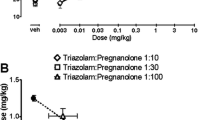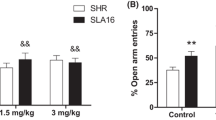Abstract
Eleven benzodiazepines were evaluated in the staircase test in mice. The behavioural parameters measured were the number of steps climbed and the number of rears during a 3-min test. Climbing and to a lesser extent rears were enhanced at low doses, whereas both parameters, particularly rearing, were reduced at higher doses. The differential effects of the drugs on the two parameters were used to determine indices of anxiolytic efficacy for each drug where increases in climbing were taken to indicate the onset of anxiolytic activity and decreases in rearing the onset of sedative activity. The compounds could be ranked according to these indices in a manner which appears to reflect their therapeutic profile in man.
Similar content being viewed by others
References
Archer J (1973) Tests for emotionality in rats and mice: a review. Anim Behav 21:205–235
Cohn JB (1983) Long and short-acting benzodiazepines. A review of the role of benzodiazepines. In: Trimble MR (ed) Benzodiazepines divided: a multidisciplinary review. Wiley, Chichester, pp 229–236
Crawley JN, Marangos PJ, Paul SM, Skolnick P, Goodwin FK (1981) Interaction between purine and benzodiazepine: inosine reverses diazepam-induced stimulation of mouse exploratory behavior. Science 211:725–727
Dantzer R (1977) Behavioral effects of benzodiazepines: a review. Biobehav Rev 1:71–86
File SE (1980) The use of social interaction as a method for detecting anxiolytic activity of chlordiazepoxide-like drugs. J Neurosci Methods 2:219–238
Haefely W, Kyburz E, Gerecke M, Möhler H (1985) Recent advances in the molecular pharmacology of benzodiazepine receptors and in the structure activity relationship of their agonists and antagonists. In: Testa B (ed) Advances in drug research. vol 14 Academic, London, pp 165–322
Hughes RN (1972) Chlordiazepoxide modified exploration in rats. Psychopharmacologia 24:462–469
Molinengo L, Ricci-Gamalero S (1970) The “staircase maze” and the “simple staircase” in the analysis of the psychopharmacological action of CNS depressants. Pharmacology 4:169–178
Nolan NA, Parkes MW (1973) The effects of benzodiazepines on the behaviour of mice on a hole-board. Psychopharmacologia 29:277–288
Overweg J, Binnie CN (1983) Benzodiazepines in neurological disorders. In: Costa E (ed) The benzodiazepines: from molecular biology to clinical practice. Raven, New York, pp 339–347
Robbins TW (1977) A critique of the methods available for the measurement of spontaneous motor activity. In: Iversen LL, Iversen SD, Snyder SH (eds) Handbook of psychopharmacology. vol 5. Plenum, New York, pp 37–82
Sepinwall J, Cook L (1980) Mechanisms of action of the benzodiazepines: behavioral aspects. Fed Proc 39:3021–3031
Simiand J, Keane PE, Morre M (1984) The staircase test in mice: a simple and efficient procedure for primary screening of anxiolytic agents. Psychopharmacology 84:48–53
Simon P, Soubrié P (1979) Behavioral studies to differentiate anxiolytic and sedative activity of the tranquilizing drugs. In: Boissier JR (ed) Modern problems in pharmacopsychiatry: anxiolytics and sedatives. Karger, Basel, pp 99–143
Soubrié P, Thiébot MH, Simon P, Boissier JR (1977) Effets des benzodiazepines sur les phénomènes d'inhibition qui contrôlent les comportements exploratoires et le recueil de l'information chez le rat. J Pharmacol (Paris) 8:393–403
Stephens DN, Kehr W, Schneider HH, Braestrup C (1984) Bidirectional effects on anxiety of beta-carbolines acting as benzodiazepine receptor ligands. Neuropharmacology 23:879–880
Thiébot MH, Soubrié P (1983) Behavioral pharmacology of the benzodiazepines. In: Costa E (ed) The benzodiazepines: from molecular biology to clinical practice Raven, New York, pp 67–92
Thiébot MH, Soubrié P, Simon P, Boissier JR (1973) Dissociation de deux composantes du comportement chez le rat sous l'effet de psychotropes. Application à l'étude des anxiolytiques. Psychopharmacologia 31:77–90
Thiébot MH, Soubrié P, Simon P, Boissier JR (1976) Spécificité d'action des tranquillisants mineurs dans le test de l'escalier. Relation entre ces effets et leurs propriétés anxiolytiques. J Pharmacol (Paris) 7:87–102
Treit D (1985) Animal models for the study of anti-anxiety agents: a review. Neurosci Biobehav Rev 9:203–222
Author information
Authors and Affiliations
Rights and permissions
About this article
Cite this article
Stéru, L., Thierry, B., Chermat, R. et al. Comparing benzodiazepines using the staircase test in mice. Psychopharmacology 92, 106–109 (1987). https://doi.org/10.1007/BF00215488
Received:
Revised:
Issue Date:
DOI: https://doi.org/10.1007/BF00215488




